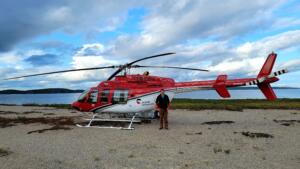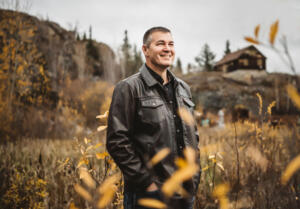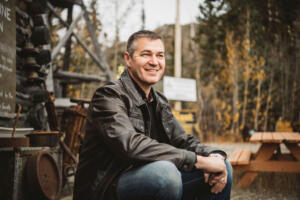In celebration of National Engineering and Geoscience Month and of all the contributions of these professions to communities in the North, NAPEG is pleased to share the following member feature on Glen Sibbeston, P.Eng., a mechanical engineer based in Yellowknife, founder of Trapline Engineering Ltd, and a Fort Simpson Métis member.
A Lifelong Northerner’s “Second Career” in Mechanical Engineering
Glen Sibbeston, P.Eng., founder of Trapline Engineering Ltd and licensed through NAPEG, hadn’t always planned on becoming an engineer. He spent his twenties as a military helicopter pilot, with his first five years in Halifax flying a Sea King off of ships.

Glen Sibbeston, P.Eng., hadn’t always planned on becoming an engineer, with his first career as a helicopter pilot.
After that contract ended, he came back home to the North to fly commercially. A Fort Simpson Métis member, Sibbeston spent half of his childhood in Fort Simpson – an island community located where the Mackenzie and Liard rivers meet, 500 km west of Yellowknife – until his family moved to the city. “I’m well acquainted with small communities in the North,” Sibbeston says.
By his early thirties he knew he wanted to shift his career. “I had always had exposure to aircraft engines and systems. They’re so ingenious in aircraft,” Sibbeston explains. That inspired him to apply to a mechanical engineering program at the University of Alberta.
“The opportunity cost to go back to university when you’re already in one career is so high that failure was not an option. I was going there and I was going to pass it,” he shares. He did exactly that and graduated in 2008, working in Yellowknife for consulting companies as a mechanical engineer by that following year.
In 2021, after more than a decade working in engineering and one year into the COVID-19 pandemic, Sibbeston saw that the industry’s productivity was lagging. He took the opportunity to step out on his own, founding his firm Trapline Engineering Ltd.
“I was able to jump in and create small business systems that were very agile,” he explains. “Having a small firm, my focus was delivering the same quality and attentiveness but just being able to do it a little bit quicker.”
Local Knowledge and Experience
Over the last several years, Sibbeston and his team at Trapline Engineering have worked with companies and architects focused on infrastructure and buildings. With Sibbeston being a life-long Northerner, he brings insight and solutions fit for the unique challenges of building in the North.

With Sibbeston being a life-long Northerner, he brings insight and solutions fit for the unique challenges of building in the North.
“I’ve spent my whole engineering career working in this climate – we’re working in the subarctic and Arctic regions of Canada and it’s harsh,” he explains. “We’ve got the combination of extreme cold and high winds. It requires the buildings to be built differently, and in some cases, maybe a little better.”
Projects in the North, especially in small communities, also often require an understanding of shipping, logistics, ice-roads and distances, Sibbeston says. It’s part of being able to keep his projects on-track and on schedule.
“In many remote communities up in the North milk is $10 a liter and the cost of energy is high. There’s a cost and time associated with getting building materials to site,” he says. “These become prominent considerations in some projects.”
Sibbeston gives the example of applying this local knowledge and experience to a building project in a community where electricity is more than a dollar per kilowatt hour. “People who come from the south are surprised to learn we’re outside the national natural gas grid,” he says. “When electricity is 10 times more expensive than what one might expect, for a consultant to do a good job, you need to make choices that use less expensive energy sources and economize to reduce ongoing energy costs.”
Biomass, Sustainable Energy and the Land
When it comes to energy in the North, Sibbeston is particularly proud of biomass projects he’s been a part of. Biomass offsets diesel or fuel oil and replaces it with sustainable bio-sources, a relatively local option given the agricultural footprint of the two provinces south of the Northwest Territories, he says.

For Sibbeston, helping to move industry towards more sustainable and cheaper energy sources is a reflection of his values as a Northerner, Métis member and the son of a “farm girl” from Alberta.
Biomass has become more widely recognized in recent years by northern governments, the Arctic Energy Alliance and firms like Sibbeston’s as a viable alternative to fossil fuels. Some projects in the Northwest Territories have seen upwards of a 90 percent reduction in annual oil use while substantially reducing greenhouse gas emissions.
“We have the opportunity to switch a lot of our infrastructure from fossil fuels to biomass,” he explains, referencing a recent project he worked on that involved a 56-unit apartment building in Yellowknife. “These biomass boilers are big and expensive, but there are significant cost savings for the fuel over time.”
For Sibbeston, helping to move industry towards more sustainable and cheaper energy sources is a reflection of his values as a Northerner, Métis member and the son of a “farm girl” from Alberta. “I definitely have a connection to the land around us,” he says. “I understand what it means to Indigenous people and I understand the European farming connection to the land, too.”
With this cross-cultural understanding, his insight into Northern communities, and his agile team, Sibbeston’s decision to shift to his “second career” in mechanical engineering has helped him have a big impact on the communities he comes from.
“There’s no place like home,” he shares.
Written by Kailey Morin, Writer + Communications Consultant
In collaboration with Glen Sibbeston, P.Eng.

